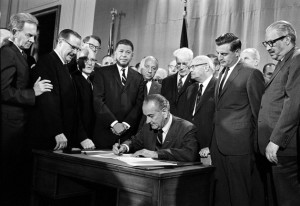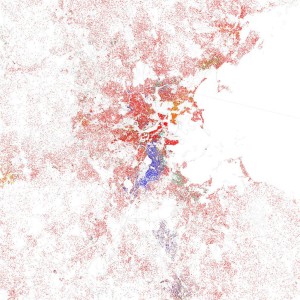When the U.S. Department of Housing and Urban Development released its AFFH rule yesterday, it was the second cause for celebration among fair housing advocates in the last two weeks.
The first was the U.S. Supreme Court decision upholding the disparate impact doctrine — a key civil rights enforcement mechanism, under which housing policies can be found discriminatory on the basis of their effects, not merely their intent.
The second was the long-awaited AFFH rule. AFFH stands for “affirmatively furthering fair housing,” language contained in the Fair Housing Act of 1968 but not fully elucidated until yesterday.
Essentially, as HUD summarizes it, the rule is a means of overcoming segregation and fostering inclusive communities. This is entirely in keeping with the intent of the Fair Housing Act’s original sponsors – chief among them Sens. Walter Mondale and Ed Brook, who can be seen flanking LBJ as the president signs the legislation into law on April 11, 1968.
The main point of the Act according to Mondale, “was to replace the segregated living patterns with ‘truly integrated and balanced living patterns.’” To Brooke, the act was meant to break the “dreary cycle of the middle-class exodus to the suburbs and the rapid deterioration of the central city.” (They said as much in their amicus brief to the Supreme Court in the disparate impact case.)
Their vision hasn’t exactly played out over the last half-century, as most major metropolitan areas remain highly segregated. Consider Boston, for example, which has a white/black dissimilarity index of 68. On a scale of 0 to 100, 0 represents total integration and 100, total segregation. Any place that registers over 60 is considered highly segregated. (The State of Vermont, by contrast, came in at 38.8, according to a 2012 report.)
In this map of the Boston area, based on 2010 Census data by Eric Fischer, red dots represent white people; blue dots, black people; orange, Hispanics; and green, Asians.
Similar maps, some even starker in the depiction of racial separation, can be seen for most major U.S. cities. The AFFH rule, which makes operational the Fair Housing Act’s intent, is seen as a tool that will help overcome these longstanding segregated patterns.
Even though Vermont is 95 percent white, AFFH will have broad application here. After all, a major thrust is to break up pockets of poverty and promote inclusive settlement patterns that give people in protected classes – among them, racial minorities and disabled people – the choice to live in low-poverty areas with access to transit and good services. Vermont has plenty of room for more housing development in keeping with AFFH standards.

